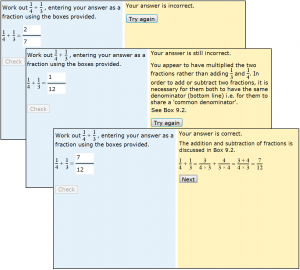Throughout the 51-year history of the UK Open University (OU), there has been some blurring of the summative (‘for measuring’) and formative (‘for learning’) roles of assessment. OU undergraduate students are typically (though no longer exclusively) adults, studying part-time alongside other commitments and they have a wide range of entry qualifications from previous higher education qualifications to, literally, none. Many have not studied for many years and so they may be particularly lacking in confidence. The students study at a distance, but the OU’s model of supported distance education means that they are usually supported by a tutor. This tutor will provide occasional tutorials (face to face or using a range of synchronous and asynchronous electronic communication technologies) and be available to support student learning by telephone or email; however a substantial part of the tutor’s contracted time will be spent in grading and providing feedback on ‘tutor-marked assignments’ (TMAs). The fact that this task is described as ‘correspondence tuition’ reflects the importance that is placed on the feedback provided by tutors to their students in this way; this is particularly important in a distance-learning organisation, where many students never meet their tutor and opportunities for informal feedback are extremely limited. However TMA scores usually contribute substantially to students’ overall course grades.
The use of e-assessment also has a long history at the Open University. TMAs have long been supplemented by computer-marked assignments (CMAs), initially comprising solely multiple choice questions, with students’ responses entered on machine-readable forms and submitted by post. Now, students complete online interactive computer-marked assignments (iCMAs) from their own computers at home.
The Open University is global maintainer of the Moodle Quiz engine and added functionality is provided by use of the ‘OpenMark’ system. OpenMark was developed at the Open University but is now open source. Question types include those requiring free text entry of numbers, letters, words and sentences in addition to more conventional drag and drop, multiple choice, multiple response and hotspot questions. Students are allowed three attempts at each question, with increasingly detailed and tailored prompts allowing them to act on the feedback whilst it is still fresh in their minds and so to learn from it, as illustrated in the simple question shown in the Figure. The hints frequently refer students back to relevant course material (which might be a book, a video sequence or an interactive activity). Feedback can also be provided on the student’s demonstration of learning outcomes developed in the preceding period of study. OpenMark has good accessibility features and wherever possible, questions exist in several variants. In summative use this enables different students to receive different assignments, whilst in formative-only use, the different questions provide extra opportunities to practise.


Pingback: e-assessment (f)or learning » E-assessmen...